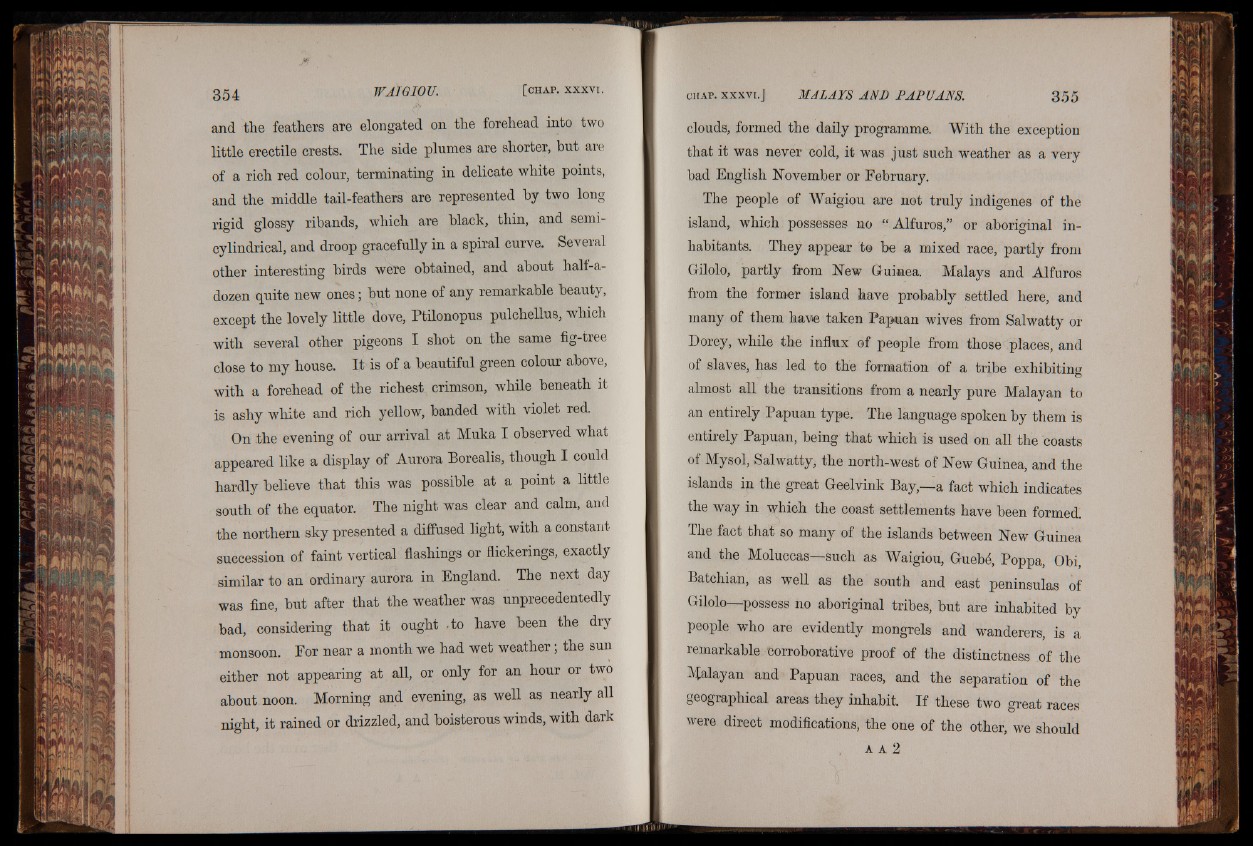
and the feathers are elongated on the forehead into two
little erectile crests. The side plumes are shorter, but are
of a rich red colour, terminating in delicate white points,
and the middle tail-feathers are represented by two long
rigid glossy ribands, which are black, thin, and semi-
cylindrical, and droop gracefully in a spiral curve. Several
other interesting birds were obtained, and about half-a-
dozen quite new ones; but none of any remarkable beauty,
except the lovely little dove, Ptilonopus pulchellus, which
with several other pigeons I shot on the same fig-tree
close to my house. It is of a beautiful green colour above,
with a forehead of the richest crimson, while beneath it
is ashy white and rich yellow, banded with violet red.
On the evening of our arrival at Muka I observed what
appeared like a display of Aurora Borealis, though I could
hardly believe that this was possible at a point a little
south of the equator. The night was clear and calm, and
the northern sky presented a diffused light, with a constant
succession of faint vertical flashings or flickerings, exactly
similar to an ordinary aurora in England. The next day
was fine, but after that the weather was unprecedentedly
bad, considering that it ought -to have been the dry
monsoon. For near a month we had wet weather; the sun
either not appearing at all, or only for an hour or two
about noon. Morning and evening, as well as nearly all
night, it rained or drizzled, and boisterous winds, with dark
clouds, formed the daily programme. With the exception
that it was never cold, it was just such weather as a very
bad English November or February.
The people of Waigiou are not truly indigenes of the
island, which possesses no “ Alfuros,” or aboriginal inhabitants.
They appear to be a mixed race, partly from
Gilolo, partly from New Guinea. Malays and Alfuros
from the former island have probably settled here, and
many of them have taken Papuan wives from Salwatty or
Dorey, while the influx of people from those places, and
of slaves, has led to the formation of a tribe exhibitingO
almost all the transitions from a nearly pure Malayan to
an entirely Papuan type. The language spoken by them is
entirely Papuan, being that which is used on all the coasts
of Mysol, Salwatty, the north-west of New Guinea, and the
islands in the great Geelvink Bay,—a fact which indicates
the way in which the coast settlements have been formed.
The fact that so many of the islands between New Guinea
and the Moluccas—such as Waigiou, Gueb<5, Poppa, Obi,
Batchian, as well as the south and east peninsulas of
Gilolo—possess no aboriginal tribes, but are inhabited by
people who are evidently mongrels and wanderers, is a
remarkable Corroborative proof of the distinctness of the
Malayan and Papuan races, and the separation of the
geographical areas they inhabit. If these two great races
were direct modifications, the one of the other, we should
a a 2